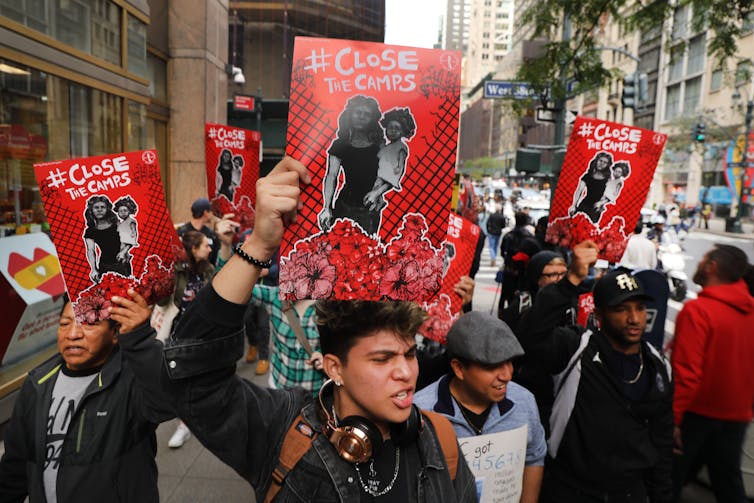Chivalry is not about opening doors, but protecting society's most vulnerable from attack
- Written by Jennifer Wollock, Professor of English, Texas A&M University
Modern society is in dispute over the value of chivalry[1]. Chivalry originally referred to the medieval knight’s code of honor but today references a range of – usually male – behaviors, from courtesy to overprotectiveness. Some see it as the mindset of elite warriors, glorifying violence and demeaning women[2]. Others see it as necessary and desirable[3] to protect groups under attack.
As a historian of literature[4] who studies chivalry, I stand with the latter group. Rather than fostering misogynistic attitudes or overprotective behaviors that insult women, chivalry has been a liberating force from ancient times onward. Across many cultures it arises to protect society’s most vulnerable.
Ancient chivalry
The earliest chivalric incident I teach appears around 2100 B.C. in “Gilgamesh,” perhaps the oldest surviving epic poem. In it, the wild man Enkidu[5], civilized by a woman, confronts the sexually abusive king Gilgamesh. Enkidu defeats Gilgamesh in hand-to-hand combat to end his custom of sleeping with every bride in his city on her wedding night, and wins that king’s friendship.
Jewish laws also influenced the chivalric customs of medieval leaders. Deuteronomy, the fifth book of the the Hebrew Bible, outlined laws of war[6] around the 7th century B.C. that require protections for captive women, peace overtures to enemies and prohibitions against destroying fruit trees. It inspired[7] the international law that nations are governed by today.
The Bible also features warrior women who emerge as chivalric figures. The prophetess Deborah, for example, accompanies an army into battle. In her visionary song[8] she praises Jael[9], the lone woman who assassinates a predatory enemy general[10] on the run. Deborah even reproaches Sisera’s mother for raising her son to plunder and enslave women as “spoils of war.”
The Middle Ages
Early medieval knights[11] were essentially hired thugs of low social status. Their adoption of chivalry as a professional code of honor allowed some of them to achieve respect as gentlemen.
European literature soon featured knights and kings as protectors of women. In Geoffrey of Monmouth[12]’s “History of the Kings of Britain[13]” of 1138, King Arthur kills the rapist giant[14] of Mont-Saint-Michel. A few decades later, the French poet Chrétien de Troyes[15] portrays Sir Lancelot casting aside reputation, glory and treasured warhorses[16] to save the kidnapped Queen Guinevere. Such popular tales of chivalry pressured aristocrats to adopt the chivalric code – to some extent.
By the later 14th and mid-15th centuries, English writers like Geoffrey Chaucer and Sir Thomas Malory depict the court of King Arthur as a bastion of justice for women, well beyond the norms of that day. In their most famous works, “The Canterbury Tales[17]” and “Le Morte d'Arthur[18],” respectively, they wrote about women sentencing rapist knights to death or reeducation. In Malory’s version of the story, King Arthur’s knights take an oath[19] that decries brutality toward women and demands they both aid women and “strengthen them in their rights[20].”
Western chivalry rapidly became a liberating force for both men and women as knights intervened to protect civilians.
 Chivalric ideals of social justice continue to inspire activists today.
Spencer Platt/Getty Images[21]
Chivalric ideals of social justice continue to inspire activists today.
Spencer Platt/Getty Images[21]
Chivalry today
As in ancient times, chivalrous medieval women themselves led armies and defended castles[22]. One of the most famous, the peasant girl Joan of Arc[23], was 18 when she led her countrymen against the English and saved French independence.
[Deep knowledge, daily. Sign up for The Conversation’s newsletter[24].]
Their inspiration has fired up a long series of activists who carry chivalric ideals of social justice into the present day. Suffragists in the 19th and early 20th centuries[25] – as well as Black Lives Matter protesters today – have identified with medieval knights destroying evil customs. “We have come together as, if you will, knights at the Round Table, and our King Arthur is justice,” said a young protester in Fort Worth, Texas[26], after the police killing of George Floyd.
Just as toxic masculinity[27] and aggressive misogyny persist, so does the original chivalric ideal of the warrior defending human life and freedom against tyranny[28] and its thugs.
The principled medieval knight – and principled men and women of whatever rank – valued self control. They joined clerics of different faiths in opposing cruelty when law and bigotry gave victims little recourse.
Inequities[29] and prejudices[30] have not disappeared since the days of King Arthur. I believe men and women of today need the chivalric values[31] of mercy, justice and humility more than ever before.
References
- ^ chivalry (doi.org)
- ^ demeaning women (msmagazine.com)
- ^ necessary and desirable (www.theatlantic.com)
- ^ historian of literature (scholar.google.com)
- ^ Enkidu (www.britannica.com)
- ^ laws of war (doi.org)
- ^ inspired (global.oup.com)
- ^ visionary song (www.biblegateway.com)
- ^ praises Jael (jwa.org)
- ^ predatory enemy general (www.biblegateway.com)
- ^ Early medieval knights (books.google.com)
- ^ Geoffrey of Monmouth (biography.yourdictionary.com)
- ^ History of the Kings of Britain (www.penguinrandomhouse.com)
- ^ rapist giant (en.normandie-tourisme.fr)
- ^ Chrétien de Troyes (www.ancient.eu)
- ^ treasured warhorses (www.warhistoryonline.com)
- ^ The Canterbury Tales (chaucer.fas.harvard.edu)
- ^ Le Morte d'Arthur (books.google.com)
- ^ oath (books.google.com)
- ^ strengthen them in their rights (baylor-ir.tdl.org)
- ^ Spencer Platt/Getty Images (www.gettyimages.com)
- ^ led armies and defended castles (www.medievalists.net)
- ^ Joan of Arc (www.biography.com)
- ^ Sign up for The Conversation’s newsletter (theconversation.com)
- ^ Suffragists in the 19th and early 20th centuries (www.publicmedievalist.com)
- ^ young protester in Fort Worth, Texas (www.star-telegram.com)
- ^ toxic masculinity (www.nytimes.com)
- ^ freedom against tyranny (www.washingtonpost.com)
- ^ Inequities (inequality.stanford.edu)
- ^ prejudices (www.pewresearch.org)
- ^ chivalric values (pepperdine-graphic.com)
Authors: Jennifer Wollock, Professor of English, Texas A&M University

